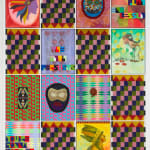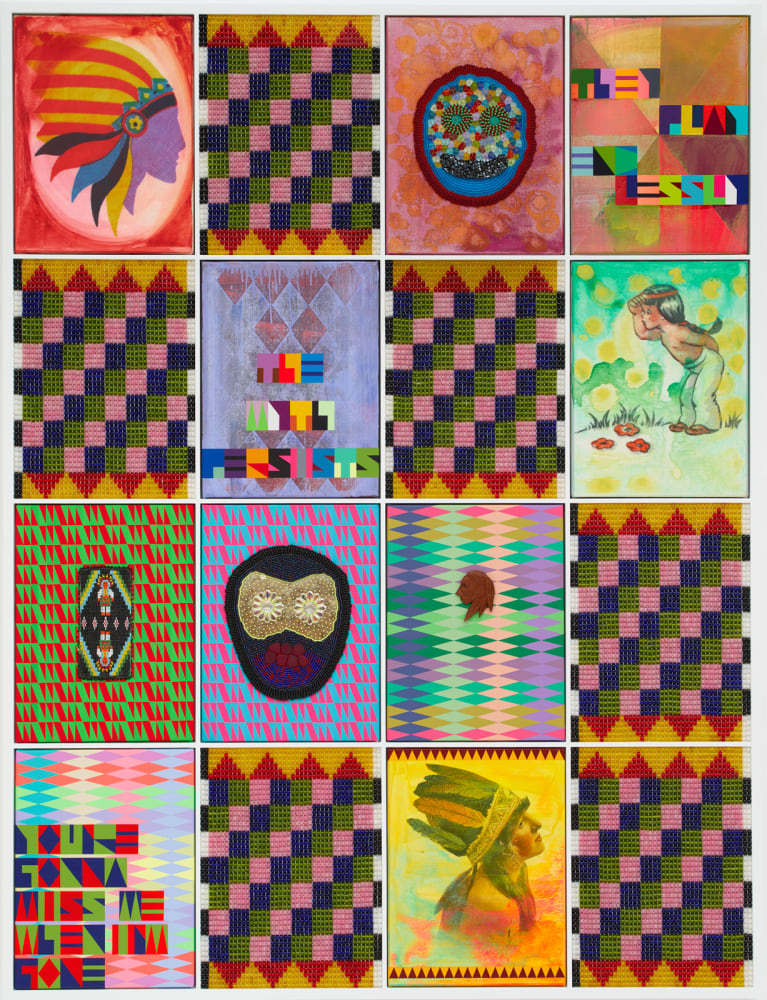-
Artworks
Jeffrey Gibson USA, b. 1972
THEY PLAY ENDLESSLY, 2021Canvas, Acrylic Paint, Vintage Beaded Wallet, Vintage Wooden Broach, Archival Pigment Print on Rice Paper, Glass Beads, Artificial Sinew, Hematite Beads, Plastic Beads, Druzy Beads, Metal Sequins, Turquoise Beads, Nylon Thread66 1/2 x 50 1/2 x 3 1/4 in
168.9 x 128.3 x 8.3 cm7995Further images
-
(View a larger image of thumbnail 1
)

-
(View a larger image of thumbnail 2
)

-
(View a larger image of thumbnail 3
)

-
(View a larger image of thumbnail 4
)

-
(View a larger image of thumbnail 5
)

-
(View a larger image of thumbnail 6
)

-
(View a larger image of thumbnail 7
)

-
(View a larger image of thumbnail 8
)

This work belongs to a series of Quilt Block Paintings Jeffrey Gibson debuted in 2021 in his solo exhibition Beyond the Horizon at Kavi Gupta in Chicago. The series marks...This work belongs to a series of Quilt Block Paintings Jeffrey Gibson debuted in 2021 in his solo exhibition Beyond the Horizon at Kavi Gupta in Chicago. The series marks a critical turning point in Gibson’s practice, where he is for the first time overtly deploying appropriated figurative imagery in his work. For these works, he incorporates images of Indigenous people and Native American culture created by non-Indigenous people, such as Elbridge Ayer Burbank (1858-1949), who famously painted the portraits of more than a thousand Indigenous people. These images flatten and oversimplify Indigenous people, diminishing their complex humanity while simultaneously idealizing them as caricatures. They reflect the image many Americans still have today of Indigenous people as proud and brave, yet primitive and vanishing.
The pastiche appearance of Gibson’s ambitious Quilt Block Paintings is a material reflection of the intertextual narratives within. Says Gibson, “My grandmothers made quilts, and I collect quilts. I’m drawn to their patchwork quality. If you know where the fabrics are coming from, there’s a story that can be played out through material culture.”
Ranging from the cartoonish, to the melodramatic, to the profane, the appropriated images in the works draw attention to inherent biases within intercultural visual narratives, such as the tendency of non-Indigenous artists to attribute dark skin tones to their perceived foes and light skin to individuals, such as Pocahontas, whom they wish to convey as friendly to colonial concerns. The works deftly interrogate differences between how Native Americans represent themselves and how they are represented by others.
Also interwoven into many of the panels are delicate, beaded objects dating from the mid-19th to mid-20th centuries. Taken from Gibson’s private collection, these items were often made for personal reasons by their intended users, and other times made as “whimseys,” so-called because of their value to tourists as objects of wonder and amusement. Incorporating traditional and global materials, these beaded objects elucidate a crucial turning point more than a century and a half ago, when sudden access to global trade allowed Native American artists to expand their visual and material lexicon. Such moments amplify awareness of Modernism not as a one-time Western phenomenon, but a continuous and manifold spectrum.
Artist Background:
Jeffrey Gibson (b. 1972, USA) is a multi-disciplinary artist whose work explores the contemporary confluence of Modernism, personal identity, culture, history, and international social narratives. Gibson is a member of the Chocktaw and Cherokee nations. He currently lives and works in Hudson, New York. Gibson’s practice has manifested across several dynamic and diverse bodies of work, in which materials traditional to Native American art, such as animal hides, beads, and tipi poles, intermingle with materials like spray paint, acrylics, ceramic, and tape. -
(View a larger image of thumbnail 1
)








